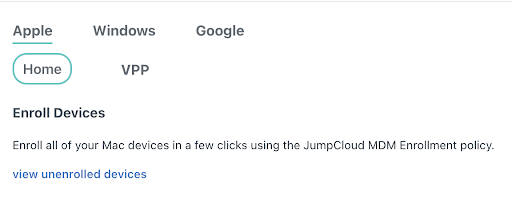Updated on January 11, 2024
Some IT departments are “Microsoft-centric,” and that’s okay, because JumpCloud’s open directory platform offers several ways to incorporate Microsoft systems into its unified device and identity access management. User-led Windows MDM enrollment is a new option that will help blaze a path to the cloud.
It augments JumpCloud’s Windows agent by making it easier to deploy software and updates, meet compliance requirements, and has the added benefit of leveraging Microsoft’s latest mobile device management (MDM) capabilities. IT organizations can leverage their time, investment, and experience using Microsoft technologies to modernize their infrastructure.
This article introduces Windows MDM and outlines how it works even better when it’s combined with unified device management and integrated identity and access management (IAM).
The Benefits of Windows MDM
Windows MDM introduces a self-service onboarding workflow that makes it easier to manage Windows devices with the confidence that the end-user experience is compliant and secure. JumpCloud’s Windows agent makes reporting, support, and IT management easier.
Efficient Deployment with Windows Provisioning Packages
Facilitate small and bulk deployment with Windows Provisioning Packages. Reduce manual efforts, securely speed up deployment process, and improve overall end-user experience.
Simplified Enrollment
JumpCloud’s Windows MDM provides a self-service onboarding workflow. It’s easy for end users to complete and results in the device being enrolled in MDM and managed via the JumpCloud agent. There’s no longer a need to install an agent and use a connect key.

Tamper-Proof Policies and Configurations
Tamper protection ensures that MDM-enrolled devices will always have the JumpCloud agent installed and any attempts by end users to remove the JumpCloud agent will result in MDM reinstalling the agent. Windows MDM is supported on Windows 10 and 11 devices.
Automated MDM agent enrollment
Admins can enroll all existing JumpCloud agent managed Windows MDM supported devices with a single click.
Unified Device Management without Lock-in

Unified device management eliminates the need for on-premises solutions such as Active Directory (AD) or Microsoft Configuration Manager (historically known as SCCM) or to buy and support point solutions. JumpCloud offers device management for Android, Apple, Linux, and Windows endpoints. Device postures are enabled through policy templates to establish a secure user experience.
- JumpCloud provides an agentless approach for Android devices through Enterprise Mobility Management (EMM) and MDM, respectively. Apple devices can even be provisioned via zero-touch enrollment. Windows MDM takes advantage of the latest Microsoft device enrollment and management features. Significantly, it ends dependence on Microsoft to manage Windows devices.
- Agents enforce policies and execute root-level commands for Apple, Linux, and Mac endpoint security and compliance. JumpCloud collects telemetry that can be processed into curated reports, and is aggregated by JumpCloud’s System Insights tool. The agent makes it possible to include unlimited remote assistance through the JumpCloud admin portal as well as optional OS and browser patch management for all desktop OSs.
- Optional conditional access policies deploy certificates to ensure that only managed devices are capable of accessing resources. IAM is discussed in further detail below.
Another Path to the Cloud
Microsoft shops may feel that Azure Active Directory (AAD) and Intune are the only options to migrate an AD domain to the cloud. JumpCloud provides unified device management with IAM features and integrates with AD without being locked into an Azure-only environment.
Check out how JumpCloud compares to AAD and Intune.
How MSPs Benefit from Windows MDM
Managed service providers (MSPs) are often extremely experienced using Microsoft technologies to build out their product offerings for securing the Windows devices. The IT solutions that they adopt directly impact their ability to serve their customers. Fortunately, JumpCloud’s Windows MDM uses familiar technologies that are well understood and vetted.
Traditionally, some MSPs have opted not to take clients outside of the Microsoft ecosystem, because it adds another toolset and additional costs to manage those new clients. JumpCloud’s unified device management (featuring Windows MDM) in addition to its Google Workspace partnership, makes it possible for MSPs to seamlessly add clients outside of the Microsoft ecosystem. They’re now able to manage all of their clients the same way.
JumpCloud future-proofs MSPs by managing today’s client ecosystems, as well as tomorrow’s. It also unifies your IT stacks and simplifies management with IAM with device management.
JumpCloud Integrates IAM with Device Management
JumpCloud integrates its unified device management with IAM, regardless of the underlying authentication method or device ecosystem. This combination makes identities the new perimeter and enables Microsoft-centric shops to use familiar solutions if they want to.
The open directory platform authenticates users whether they use biometrics, digital certificates, passwords, or SSH keys. Secure, frictionless access is fundamental for IT organizations and JumpCloud ensures that every resource has a best way to connect to it. For example:
- Servers use SSH keys, which are more secure than passwords.
- Passwordless certificates can secure RADIUS Wi-Fi access.
- Access on-premise network devices and apps using cloud LDAP.
- Web applications use SAML and OIDC for authentication and seamless single sign-on (SSO). Dynamic groups ensure that only users that have the appropriate entitlements can access resources.
- Conditional access rules are option for privileged access management.
JumpCloud’s Directory Insights and pre-built reports such as SSO to users offer event logging for compliance.
Try JumpCloud’s Windows MDM
JumpCloud is available through a free trial. There’s no additional charge for unified device management, which secures every endpoint that accesses your assets to enforce and demonstrate meeting your compliance requirements.



